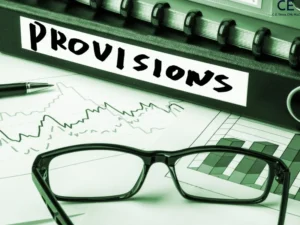
What is a Tax Provision? A Guide for Businesses
What is tax provision and what is it used for? Understanding and planning for income taxes is essential for every small business owner. Among the key concepts is the tax provision, which helps ensure that a business sets aside the right amount to cover its tax liabilities each year. For companies looking to improve financial reporting accuracy, understanding how to calculate tax provisions and manage the associated challenges is invaluable.
Join our Raleigh CPAs as we answer the question, "What is a tax provision?", break down the essentials of tax provisioning, and help small businesses understand its importance and navigate the complexities of accurate financial reporting.
What is Tax Provision?
What is tax provision? A tax provision represents the total income tax expense for a reporting period, including federal, state, local, and, where applicable, foreign income taxes. Governed by ASC 740 under U.S. GAAP, the tax provision focuses exclusively on taxes based on income—excluding sales, payroll, or property taxes.
The provision consists of two components—current and deferred income tax expenses.
Current Income Tax Expense
This is the tax due for the current period, calculated by applying current tax law to the taxable income or loss for that period.
Deferred Income Tax Expense
This is an anticipated future tax expense arising from timing differences between book and tax values for certain items, often stemming from differences in accounting and tax reporting rules.
The Tax Provision Process
The tax provision process is a structured approach to calculating and reporting the income tax components of a company’s financial statements. This process not only ensures compliance with tax regulations but also aligns with financial reporting standards, providing a clearer picture of a company’s overall tax obligations.
Producing Income Tax Components for Financial Statements
The main purpose of the tax provision process is to prepare accurate income tax data to be included in a company’s financial statements. By integrating this information, businesses can effectively present their tax liabilities, providing stakeholders with insight into how taxes impact the company’s financial position.
This tax preparation process is particularly crucial for investors and management, as it reflects a comprehensive view of tax obligations for the full year.
Key Steps in Calculating the Tax Provision
Now that we have addressed the question, "What is tax provision", we can guide you on how to calculate it. While calculating the tax provision can involve detailed steps, understanding the core stages simplifies this complex process.
Here are the primary steps that businesses typically follow:
- Estimation of Taxable Income: Calculating a tax provision begins by estimating taxable income, which includes analyzing net revenue, deductions, and other financial data. Accurate estimation is crucial for a reliable provision.
- Determining Applicable Tax Rates: After estimating income, businesses identify applicable tax rates at local, state, federal, and, for multinationals, international levels. These rates are then applied to determine tax liabilities.
- Adding a Buffer: Some companies add a buffer to their provision as a cushion for unexpected tax code changes or income fluctuations, helping ensure accuracy despite potential adjustments.
Tax Provision Formula
To calculate a tax provision, a basic formula might look like this:
Tax Provision = (Estimated Net Taxable Income x Estimated Tax Rates) + Buffer Amount.
This formula simplifies a more intricate process, as accurately estimating net taxable income and selecting the appropriate tax rates requires careful financial assessment. Ultimately, the provision provides a guideline, while the actual income tax amount is calculated based on:
Income Tax = Net Taxable Income x Applicable Tax Rates.
Calculating the Full-Year Tax Provision
The tax provision process often focuses on a full-year or annual computation, allowing companies to forecast total tax obligations for the fiscal year. This annual provision is reported within the financial statements, aligning with Generally Accepted Accounting Principles (GAAP) requirements. Ensuring compliance with the annual reporting standards provides consistency, and stakeholders can trust the accuracy of a company’s financial information.

Navigating ASC 740
The complexity of the tax provision process extends beyond calculations to involve adherence to ASC 740, the U.S. GAAP standard that governs accounting for income taxes. ASC 740 provides guidelines for recognizing and reporting tax provisions, linking financial statements with actual tax liabilities.
To comply with ASC 740, tax preparers must be knowledgeable in both technical tax regulations and GAAP accounting rules. This knowledge ensures that tax provisions align with regulatory standards, offering clarity and accuracy in financial statements.
Why Accurate Tax Provisioning Matters
An accurate tax provision process enables businesses to manage their finances more effectively, meeting compliance requirements and avoiding potential discrepancies. Proper provisioning also gives management and shareholders a clear view of how tax obligations influence earnings, promoting informed financial decision-making.
By following these key steps and adhering to ASC 740, businesses can streamline the tax provision process, allowing for efficient tax reporting and accurate financial representation.
Common Tax Provision Challenges and Solutions
Navigating tax provisioning is no easy task, especially with shifting tax laws and the differences between GAAP and tax accounting rules. Below are some common challenges small business accounting teams face, along with insights on how to manage them effectively.
Bridging Differences Between GAAP and IRS Rules
One major challenge is aligning GAAP accounting standards with IRS tax rules, which don’t always treat income and expenses the same way. GAAP standards prioritize financial accuracy for shareholders, while IRS rules focus on taxable income.
This mismatch means that accountants need to carefully adjust financial data to meet both requirements. Regularly reviewing updated tax guidelines and maintaining clear documentation for adjustments can help ensure accurate, compliant reporting.
Estimating Temporary Differences
Temporary differences—timing gaps between when income or expenses are recognized in financial statements versus tax filings—can complicate tax provisions. For example, revenue might be reported in one period for GAAP purposes but recognized for tax purposes in a different period.
Accurately estimating these differences is essential for determining current and deferred tax expenses. Developing a system to monitor and adjust for these timing differences can help manage this process effectively and reduce errors.
Integrating Data from Multiple Sources
Tax provisioning often requires pulling data from various financial systems, which can make data management challenging. Information on revenue, expenses, and adjustments must be collected and organized consistently to ensure accurate provision calculations.
To streamline this, consider using an integrated accounting system or a centralized data management tool. These tools can improve data accuracy, making the tax provisioning process faster and more reliable.
Data Management and Reliability in Tax Provisioning
Effective data management is crucial for simplifying and speeding up the tax provisioning process. Reliable, organized data minimizes errors and ensures a smoother tax season. Below are essential practices for maintaining high data quality in your tax provisioning.
Establish a Clear Chart of Accounts (CoA)
Starting with a well-structured Chart of Accounts (CoA) helps track transactions accurately within a specific financial period. A good CoA structure organizes every income, expense, asset, and liability in a clear, consistent manner, making it easier to monitor and report financial activity. Regularly updating and refining the CoA helps maintain accuracy in financial statements, setting a strong foundation for tax calculations.
Build a Reliable Financial Reporting Foundation
Accurate data underpins reliable financial reporting. Keeping financial data consistent and well-documented enables smoother tax calculations and reduces the risk of mistakes. Ensuring your data aligns with best practices and reporting standards makes tax provisioning more efficient and manageable, preventing issues when preparing financial statements.
Maintain Clean, Organized Data for Tax Provisioning
Reliable data is the key to faster, more accurate tax seasons. By maintaining clean data and following a structured accounting approach, companies can avoid unnecessary delays and errors, allowing for a more streamlined tax provisioning process. With strong data management, accounting teams can focus on strategic tax planning rather than fixing data issues.
Tax Provisioning FAQs
Are tax provisions and deferred tax the same?
Not exactly. While a tax provision includes both current and deferred tax components, deferred tax specifically represents timing differences that affect future tax liabilities. Deferred tax is recorded as a liability but doesn’t have to be paid by year-end, unlike the current tax expense, which reflects the tax due for the current period.
What is a corporate tax provision?
A corporate tax provision is an estimated amount a company sets aside to cover anticipated tax liabilities. This amount is calculated based on projected income and applicable tax rates. By creating a tax provision, corporations ensure they’re prepared to meet tax obligations without disrupting cash flow, even before the exact tax amount is finalized.
How is a tax provision calculated?
Calculating a tax provision involves estimating both effective tax rates and taxable income for the year. While this sounds straightforward, it can be complex due to differing accounting standards and temporary and permanent adjustments.
A standard formula is:
Tax Provision = (Estimated Net Taxable Income x Estimated Tax Rates) + Buffer Amount
Ensure Accurate Tax Provisioning with a Raleigh CPA
A tax provision is a key component of financial statements, impacting earnings and overall compliance with ASC 740. By following the outlined steps, businesses can establish precise and compliant tax provisioning practices, promoting transparent and reliable financial reporting.
If you’re looking to simplify your tax provisioning and enhance financial clarity, reach out to C.E. Thorn, PLLC, CPA. See how our Raleigh team of accounting professionals can help your business navigate tax season.
Call us today at 919-420-0092 or fill out the form below to get started.
Contact Form
Feel free to call our office or to complete the contact form below:
"*" indicates required fields
